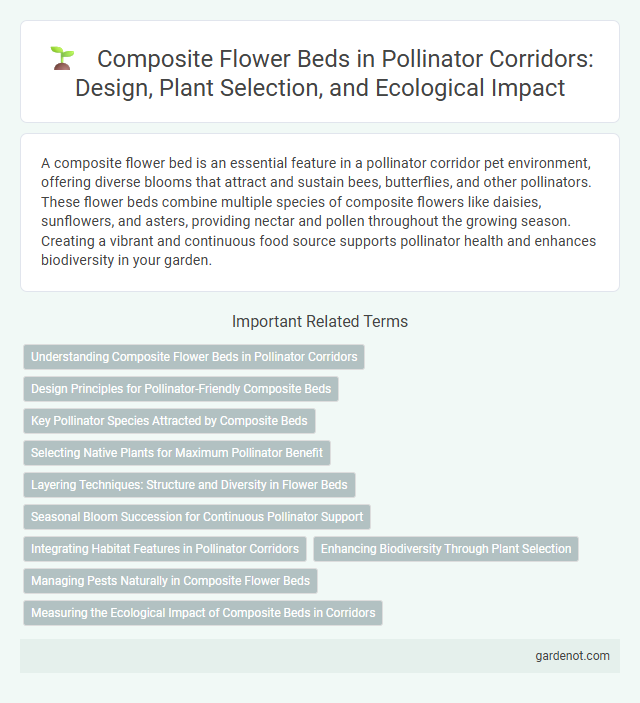A composite flower bed is an essential feature in a pollinator corridor pet environment, offering diverse blooms that attract and sustain bees, butterflies, and other pollinators. These flower beds combine multiple species of composite flowers like daisies, sunflowers, and asters, providing nectar and pollen throughout the growing season. Creating a vibrant and continuous food source supports pollinator health and enhances biodiversity in your garden.
Understanding Composite Flower Beds in Pollinator Corridors
Composite flower beds consist of diverse flowering plants from the Asteraceae family, such as sunflowers, daisies, and asters, which are essential for supporting pollinator corridors. These beds provide abundant nectar and pollen resources that attract and sustain vital pollinator species including bees, butterflies, and hummingbirds throughout their foraging season. Integrating composite flower beds in pollinator corridors enhances biodiversity, promotes ecosystem health, and improves habitat connectivity for pollinators.
Design Principles for Pollinator-Friendly Composite Beds
Design principles for pollinator-friendly composite flower beds emphasize selecting a diverse range of native flowering plants that bloom sequentially throughout the growing season, ensuring continuous nectar and pollen availability. Incorporating various flower shapes and colors attracts a wide variety of pollinators such as bees, butterflies, and hummingbirds, enhancing biodiversity. Utilizing organic soil amendments and avoiding pesticides fosters a healthy habitat that supports pollinator health and encourages natural pollination processes.
Key Pollinator Species Attracted by Composite Beds
Composite flower beds, featuring species like sunflowers, coneflowers, and zinnias, attract key pollinator species including bumblebees, honeybees, and monarch butterflies. These plants provide abundant nectar and pollen resources critical for the foraging needs of diverse pollinators throughout the growing season. The structural diversity and extended bloom periods of composite flowers support pollinator health and biodiversity within pollinator corridors.
Selecting Native Plants for Maximum Pollinator Benefit
Selecting native plants for composite flower beds enhances pollinator corridors by providing essential nectar and pollen resources specific to local pollinators. Native species such as coneflowers (Echinacea), black-eyed Susans (Rudbeckia), and asters attract a diverse range of bees, butterflies, and other pollinators while supporting regional biodiversity. Incorporating a variety of bloom times and flower shapes ensures continuous forage availability and habitat connectivity throughout the growing season.
Layering Techniques: Structure and Diversity in Flower Beds
Layering techniques in composite flower beds enhance pollinator corridors by creating structural complexity and floral diversity that attract a wide range of pollinators. Incorporating native perennials, grasses, and flowering shrubs in varying heights and bloom times ensures continuous nectar and pollen sources, supporting pollinator health. Strategic layering improves habitat connectivity and resilience, fostering robust ecosystems within urban and rural environments.
Seasonal Bloom Succession for Continuous Pollinator Support
Composite flower beds planted with a diverse range of species ensure seasonal bloom succession, providing continuous nectar and pollen sources for pollinators from early spring through late fall. Incorporating native asters, goldenrods, and coneflowers supports a variety of bees, butterflies, and other beneficial insects throughout changing seasons. This strategic planting enhances habitat connectivity in pollinator corridors, promoting sustained ecosystem health and biodiversity.
Integrating Habitat Features in Pollinator Corridors
Composite flower beds in pollinator corridors provide essential nectar and pollen resources that support diverse pollinator species like bees, butterflies, and hoverflies. Integrating native flowering plant species with varying bloom times ensures continuous forage throughout the seasons, enhancing habitat connectivity and promoting pollinator health. Structural features like layered vegetation and sheltered areas contribute to nesting and protection needs, fostering resilient and thriving pollinator populations.
Enhancing Biodiversity Through Plant Selection
Composite flower beds designed with a diverse array of native Asteraceae species play a crucial role in enhancing biodiversity by providing continuous forage for pollinators such as bees, butterflies, and hoverflies throughout the growing season. Selecting plants with staggered bloom times and varied flower structures increases habitat complexity, supporting a wide range of pollinator species and promoting ecosystem resilience. Incorporating drought-tolerant and nutrient-rich composites further ensures sustainability and optimal nourishment for pollinators within the corridor.
Managing Pests Naturally in Composite Flower Beds
Composite flower beds attract diverse pollinators by providing abundant nectar and pollen sources, creating a natural ecosystem balance that reduces pest outbreaks. Beneficial insects like ladybugs and lacewings thrive in composite flower beds, feeding on aphids and other harmful pests, effectively managing pest populations without synthetic chemicals. Incorporating companion planting within composite flower beds enhances pest control by attracting predatory insects and improving plant health, ensuring sustainable pollinator habitat maintenance.
Measuring the Ecological Impact of Composite Beds in Corridors
Measuring the ecological impact of composite flower beds in pollinator corridors involves assessing biodiversity indices, pollinator visitation rates, and plant reproductive success. Studies show composite beds, dominated by Asteraceae species, enhance habitat connectivity and provide continuous forage resources, boosting native pollinator populations. Monitoring soil health and floral phenology further quantifies the contribution of composite beds to ecosystem resilience and pollination services.
Composite flower bed Infographic

 gardenot.com
gardenot.com